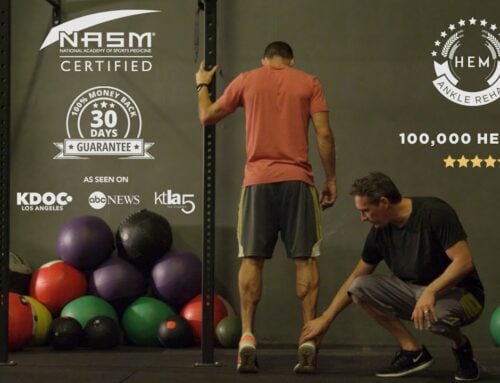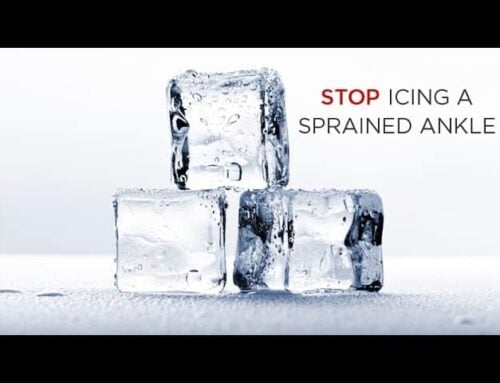
Dealing with an ankle sprain can be a real pain, both literally and figuratively. Ankle sprains are common injuries that occur when the ligaments supporting the ankle joint are stretched or torn, leading to discomfort and immobility. While they can range from mild to severe, understanding the best ways to treat an ankle sprain can significantly speed up recovery and help prevent future injuries. Whether you’ve sprained your ankle for the first time or have recurrent issues, knowing how to care for a sprained ankle is crucial for regaining full ankle function.
Understanding Ankle Sprains
What is an Ankle Sprain?
An ankle sprain happens when you twist, roll, or awkwardly turn your foot, causing the ankle ligaments to stretch beyond their limits. These ligaments are tough bands of tissue that help stabilize the ankle joint, and when they are damaged, it results in pain and swelling. Depending on the severity, an ankle sprain can range from a minor stretch of the ligament to a complete tear. A sprained ankle can significantly limit your range of motion and lead to instability if not properly treated, making it essential to diagnose and treat the injury promptly.
The most common type of ankle sprain is known as an inversion sprain, where the foot rolls inward. A high ankle sprain, though less common, affects the ligaments that connect the two bones of the lower leg, the tibia and fibula. It’s crucial to differentiate between a sprain and a more serious injury like a broken ankle, as the treatment plans differ substantially. If you experience severe pain and swelling, it might be wise to get an x-ray to rule out any fractures.
What Causes Ankle Sprains?
Ankle sprains are often caused by activities that require quick changes in direction or jumping. Sports like basketball, soccer, and running are common culprits. However, simply stepping on an uneven surface can also lead to a sprained ankle. Wearing improper footwear and having weak ankle ligaments or muscles can increase the risk of an ankle injury. Instability in the foot and ankle can predispose you to more frequent sprains, making it vital to strengthen the surrounding muscles through rehabilitation exercises.
Environmental factors, such as slippery surfaces or poor lighting, can also contribute to the likelihood of an ankle sprain. Those with a history of ankle injuries are more susceptible to future sprains, as previous injuries might have weakened the ankle joint over time. Understanding these causes can help you take preventative measures to protect your ankles from future harm, whether through improving your balance or choosing the right shoes for your activities.
How Severe Can Ankle Sprains Be?
Ankle sprains are classified into three grades, depending on the severity of the ligament damage. A Grade 1 sprain involves minor stretching and microscopic tears, resulting in mild pain and swelling. A Grade 2 sprain is a partial tear of the ligament, which causes moderate pain, swelling, and difficulty walking. This type of sprain often requires more intensive treatment and rehabilitation. The most severe, a Grade 3 sprain, involves a complete tear of the ligament, leading to severe pain, significant swelling, and a complete loss of ankle function.
Grade 3 sprains can sometimes be mistaken for a broken ankle due to the intense pain and inability to bear weight on the foot. It’s essential to properly assess the injury, often requiring an x-ray or MRI for accurate diagnosis. Depending on the severity, the treatment plan might include immobilization, physical therapy, and in some cases, surgery. Properly understanding the severity of your sprained ankle can guide you towards the most effective treatment, ensuring a full recovery and reducing the risk of chronic ankle instability.
Initial Treatment: HEM Ankle Rehab
What Does H.E.M. Stand For?
HEM Ankle Rehab is a comprehensive method designed to speed up the recovery process of a sprained ankle. H.E.M. stands for Healing, Exercise, and Movement, which are the core components of this rehabilitation program. The goal is to promote healing through active rest and strategic exercises that enhance blood flow and reduce swelling. The movement aspect focuses on restoring the range of motion and strengthening the injured ankle to prevent future sprains.
This method contrasts with the traditional R.I.C.E. (Rest, Ice, Compression, Elevation) approach by integrating movement early in the recovery phase. The HEM method encourages gentle exercises that help the ligament heal without causing further injury. By focusing on these three elements, the HEM ankle rehab system provides a structured approach to manage ankle sprain recovery effectively, ensuring that the ankle joint regains its stability and strength.
How Does HEM Ankle Rehab Help Your Heal?
The HEMAnkle Rehab program is designed to accelerate healing by addressing the key aspects of ankle recovery. The focus on healing involves reducing swelling and pain through the use of ice packs and compression techniques. These methods help minimize inflammation and promote circulation, which is vital for tissue repair. The exercise component introduces controlled movements that gently stretch and strengthen the ligaments, improving stability and range of motion over time.
Movement is incorporated early to prevent stiffness and promote flexibility, which is crucial for restoring full ankle function. By engaging in specific rehabilitation exercises, the HEM method aids in rebuilding strength in the injured ankle, reducing the likelihood of future sprains. This proactive approach not only speeds up the healing process but also enhances overall ankle health, allowing you to return to your daily activities with confidence.
When Should You Start the HEM Method?
It’s recommended to start the HEM ankle rehab as soon as possible after sustaining an ankle sprain. Early intervention is crucial for minimizing swelling and preventing stiffness in the injured ankle. The sooner you begin the HEM method, the faster you can expect to see improvements in pain reduction and mobility. However, it’s essential to listen to your body and avoid any movements that cause severe pain or discomfort.
Starting the HEM method promptly ensures that your ankle heals efficiently, reducing the risk of chronic issues and helping you get back on your feet sooner.
Medical Interventions
When is it Necessary to See a Doctor?
Seeking medical attention for an ankle sprain is crucial when the injury is severe or doesn’t improve with initial home treatment. If you experience intense pain, significant swelling, or an inability to put weight on your foot, a visit to the doctor is warranted. These symptoms might indicate a more severe sprain or a different injury, such as a broken ankle, that requires professional evaluation.
Your doctor might perform a physical examination or recommend an x-ray to rule out fractures and determine the extent of ligament damage. In cases where the sprain doesn’t improve after a few days of rest and home care, or if symptoms worsen, medical intervention becomes necessary. Proper diagnosis and treatment from a healthcare professional can prevent complications and guide you towards an effective recovery plan.
What Medical Treatments are Available for Severe Sprains?
For severe sprains, medical treatments focus on immobilization, reducing pain, and promoting healing. Depending on the severity, your doctor might recommend wearing a brace or cast to stabilize the ankle and allow the ligaments to heal properly. Anti-inflammatory medications can help reduce swelling and pain, providing relief during the recovery process.
In some cases, physical therapy is prescribed to aid in restoring the range of motion and strengthening the ankle. Severe sprains that involve a complete tear of the ligament might require surgical intervention to repair the damage. Your healthcare provider will assess your specific situation and tailor a treatment plan that best suits your needs, ensuring that you recover fully and regain your ankle’s functionality.
Can Physical Therapy Aid in Recovery?
Physical therapy plays a vital role in recovering from an ankle sprain, particularly for moderate to severe injuries. A physical therapist can design a personalized rehabilitation program that includes exercises to enhance strength, flexibility, and balance. These exercises are crucial for restoring the range of motion in the injured ankle and preventing future sprains.
Through guided sessions, physical therapy can help reduce pain and swelling while promoting proper healing. The therapist may use techniques like manual therapy, ultrasound, or electrical stimulation to aid recovery. By following a structured physical therapy regimen, you can ensure that your ankle heals correctly, minimizing the risk of chronic instability and allowing for a smoother transition back to normal activities.
Alternative Treatments
What Role Does Nutrition Play in Healing?
Nutrition plays a significant role in the healing process of a sprained ankle. A well-balanced diet rich in essential nutrients can support tissue repair and reduce inflammation. Consuming foods high in protein, vitamins C and D, and minerals such as zinc and calcium can aid in the recovery of damaged ligaments and promote overall joint health.
Anti-inflammatory foods, like leafy greens, fatty fish, and nuts, can help reduce swelling and pain in the injured ankle. Staying hydrated and maintaining a healthy weight can also relieve stress on the ankle joint, facilitating a quicker recovery. By incorporating these nutritional strategies into your recovery plan, you can enhance your body’s natural healing abilities and support the rehabilitation process.
Can Alternative Therapies Like Acupuncture Help?
Alternative therapies such as acupuncture have gained popularity as complementary treatments for ankle sprains. Acupuncture involves inserting thin needles into specific points on the body to stimulate healing and reduce pain. This ancient practice can help alleviate pain and swelling in the injured ankle, promoting relaxation and enhancing blood flow to the affected area.
While acupuncture is generally considered safe, it’s essential to consult with a qualified practitioner and discuss whether it’s suitable for your specific condition. Other alternative therapies, such as massage therapy and chiropractic care, may also offer benefits during recovery. Incorporating these treatments into your rehabilitation plan can provide additional support in managing pain and improving ankle function.
Preventing Future Ankle Sprains
How Does HEM Ankle Rehab Help Prevent Sprains?
The HEM Ankle Rehab method not only aids in recovery but also plays a crucial role in preventing future ankle sprains. By focusing on exercises that strengthen the ankle and improve balance, the HEM method enhances the stability of the ankle joint. This proactive approach reduces the risk of recurring sprains by reinforcing the ligaments and surrounding muscles.
Incorporating these exercises into your routine can significantly lower the chances of future injuries, allowing you to engage in physical activities with confidence. The movement and flexibility gained through the HEM method help ensure that your ankle remains resilient against unexpected twists or turns, providing long-term protection and reducing the likelihood of chronic ankle problems.
How Can Proper Footwear Reduce the Risk?
Wearing proper footwear is a simple yet effective way to reduce the risk of ankle sprains. Shoes that provide adequate support, cushioning, and stability can help maintain proper alignment of the foot and ankle, minimizing the chances of rolling or twisting the ankle. High-top shoes or those with ankle support are particularly beneficial for activities that involve jumping or quick changes in direction.
It’s essential to choose shoes that fit well and are appropriate for the specific activity you’re engaging in. For instance, running shoes are designed to absorb shock and support forward movement, while basketball shoes offer lateral support for sudden side-to-side movements. Investing in quality footwear tailored to your needs can go a long way in preventing ankle injuries and ensuring your safety during physical activities.
Are There Lifestyle Changes That Can Help?
Making certain lifestyle changes can significantly reduce the risk of ankle sprains. Engaging in regular exercise that focuses on strengthening the muscles around the ankle can enhance stability and flexibility. Incorporating balance exercises, such as standing on one leg or using a balance board, can further improve proprioception and prevent injuries.
Avoiding risky behaviors, such as walking on uneven surfaces or wearing high heels, can also minimize the likelihood of spraining your ankle. Maintaining a healthy weight reduces the stress on your ankles and lowers the risk of ligament damage. By adopting these lifestyle changes, you can create a supportive environment for your ankles, promoting their health and resilience against potential sprains.
Frequently Asked Questions
Is it Safe to Walk on a Sprained Ankle?
Walking on a sprained ankle is not recommended, especially during the initial stages of the injury. Resting the ankle is crucial to allow the ligaments to heal and reduce swelling. Putting weight on the injured ankle too soon can exacerbate pain and delay the healing process.
As the pain and swelling decrease, you can gradually reintroduce weight-bearing activities. It’s important to listen to your body and avoid any movements that cause discomfort. Consulting with a healthcare professional or physical therapist can provide guidance on when it’s safe to start walking and how to transition back to full activity without risking further injury.
What are the Signs of a More Serious Injury?
While most ankle sprains can be managed with home treatment, certain signs may indicate a more serious injury that requires medical attention. If you experience severe pain that doesn’t improve with rest, significant swelling, or an inability to bear weight on the foot, it’s crucial to seek professional evaluation. These symptoms might suggest a fracture or a complete ligament tear that necessitates specialized care.
Other warning signs include persistent bruising, numbness, or a popping sound at the time of injury. If the ankle remains unstable or feels weak even after several days of rest, consulting a doctor is advisable. Early diagnosis and treatment of more serious injuries can prevent complications and ensure a smoother recovery, allowing you to regain full ankle function efficiently.
Secret of the Pros
Everything You Need To Heal At Home
So, Why Rehab?
Most people think rest and ice will heal their ankle (even a severe sprain), but they end up with chronic ankle instability… 30% still have pain one year later!
And that causes all kinds of muscle imbalances in the body, which can lead more serious injuries, repeated ankle sprains and chronic ankle pain. It’s a terrible domino effect that can last for life.
That’s Where Rehab Comes In.
A great rehab program significantly improves how a sprained ankle heals. It eliminates pain fast and ensures your ankles are strong and stable with healthy range of motion, which helps prevent future sprains.
Rehab Is The Key To
Healing Ankle Injuries Fast
Recent studies have shown that rehab heals ankle ligaments safely and effectively. It’s the difference between the people that don’t heal a sprained ankle and the ones that do!
Injured Ankle
Without Rehab
Injured Ankle
With Rehab
HEM Ankle Rehab “Rehabs” Your Ankle

HEM is a complete ankle rehab and prehab program for the entire ankle, foot and calf complex. This is a very thorough program that contains so much more than anything else you can find online, but it’s still easy to do.
Scott will coach you through every step, as if you are with him, one on one. Just follow along with the videos to rebuild your ankle from the ground up.
You can expect pain free mobility and strong, stable ankles that are protected from an ankle sprain, without ankle braces!
REAL PEOPLE, REAL RESULTS
From Scott Malin, NASM-CPT, CES
Creator, HEM Ankle Rehab
October 15, 2025
Fifteen years ago, I had to give up what I love doing most… playing basketball. I sprained my ankles so many times that I could no longer play. It was devastating.
Like you, I used R.I.C.E. (rest, ice elevation, compression), but my ankles healed so slowly and badly, they eventually got so weak, I would sprain them just walking down the street!
Being a fitness trainer, the only thing I had going for me was a fascination with helping people get out of pain and strengthening their bodies.
So, I decided to research all the cutting edge techniques to heal an ankle sprain much faster and better than R.I.C.E.
After months of research, I discovered that icing an injury can have a negative affect on the body’s healing process. Studies show that ice can actually slow down healing and too much rest left the ankles weak and unstable. This was shocking, but only part of the story…
New research was suggesting a much more proactive approach to healing that involved much better rehab techniques proven to dramatically speed up the speed and quality of the healing process.
Instead of months, healing took only days. And, if you had a chronically weak ankle that was in pain, these techniques would quickly strengthen and stabilize the ankles.
I kept improving on these techniques, drawing from many different disciplines and simplified them.
Eventually, after many more months of trial and error, I created a simple at-home healing system with very reliable results.
Since I was a fitness trainer, I was able to help all my clients (celebrities and athletes) whenever they got injured. I was even on the news a few times.
The response from my clients and friends was so overwhelming that a few of them eventually convinced me to share it with everyone.
Today, I am humbled that over 100,000 people have healed fully and fast with my program.
So, if you have any kind of ankle injury (new or old), just follow along with me in the videos and I’ll show you exactly what to do until you are completely pain free.
My message is simple… you do not have to give up what you love. And you do not have to live with chronic pain from old injuries. Life is too short and there is a better way!
I truly hope you will start using my program so you can get your life back and do what you love, pain free (and yes, I still play basketball every week and LOVE it!)
Thank you!
Scott
Heal Your Ankle FAST ⇣

30 day money back guarantee
15 YEARS. 100K HEALED.

Secret of the Pros
Everything You Need To Heal At Home
REAL PEOPLE,
REAL RESULTS
So, Why Rehab?
Most people think rest and ice will heal their ankle (even a severe sprain), but they end up with chronic ankle instability… 30% still have pain one year later!
And that causes all kinds of muscle imbalances in the body, which can lead more serious injuries, repeated ankle sprains and chronic ankle pain. It’s a terrible domino effect that can last for life.
That’s Where Rehab Comes In.
A great rehab program significantly improves how a sprained ankle heals. It eliminates pain fast and ensures your ankles are strong and stable with healthy range of motion, which helps prevent future sprains.

Rehab Is The Key To
Healing Ankle Injuries Fast
Recent studies have shown that rehab heals ankle ligaments safely and effectively. It’s the difference between the people that don’t heal a sprained ankle and the ones that do!
Injured Ankle
Without Rehab
Injured Ankle
With Rehab
HEM Ankle Rehab
“Rehabs” Your Ankle

HEM is a complete ankle rehab and prehab program for the entire ankle, foot and calf complex. This is a very thorough program that contains so much more than anything else you can find online, but it’s still easy to do.
Scott will coach you through every step, as if you are with him, one on one. Just follow along with the videos to rebuild your ankle from the ground up.
You can expect pain free mobility and strong, stable ankles that are protected from an ankle sprain, without ankle braces!
100,000 PEOPLE HEALED-
-
-
-
-
-
-
-
-
-
-
-
-
-
-
-
-
-
From Scott Malin, NASM-CPT, CES
Creator, HEM Ankle Rehab
October 15, 2025
Fifteen years ago, I had to give up what I love doing most… playing basketball. I sprained my ankles so many times that I could no longer play. It was devastating.
Like you, I used R.I.C.E. (rest, ice elevation, compression), but my ankles healed so slowly and badly, they eventually got so weak, I would sprain them just walking down the street!
Being a fitness trainer, the only thing I had going for me was a fascination with helping people get out of pain and strengthening their bodies.
So, I decided to research all the cutting edge techniques to heal an ankle sprain much faster and better than R.I.C.E.
After months of research, I discovered that icing an injury can have a negative affect on the body’s healing process. Studies show that ice can actually slow down healing and too much rest left the ankles weak and unstable. This was shocking, but only part of the story…
New research was suggesting a much more proactive approach to healing that involved much better rehab techniques proven to dramatically speed up the speed and quality of the healing process.
Instead of months, healing took only days. And, if you had a chronically weak ankle that was in pain, these techniques would quickly strengthen and stabilize the ankles.
I kept improving on these techniques, drawing from many different disciplines and simplified them.
Eventually, after many more months of trial and error, I created a simple at-home healing system with very reliable results.
Since I was a fitness trainer, I was able to help all my clients (celebrities and athletes) whenever they got injured. I was even on the news a few times.
The response from my clients and friends was so overwhelming that a few of them eventually convinced me to share it with everyone.
Today, I am humbled that over 100,000 people have healed fully and fast with my program.
So, if you have any kind of ankle injury (new or old), just follow along with me in the videos and I’ll show you exactly what to do until you are completely pain free.
My message is simple… you do not have to give up what you love. And you do not have to live with chronic pain from old injuries. Life is too short and there is a better way!
I truly hope you will start using my program so you can get your life back and do what you love, pain free (and yes, I still play basketball every week and LOVE it!)
Thank you!
Scott
Hurry, sale ends soon!
30 day money back guarantee



























